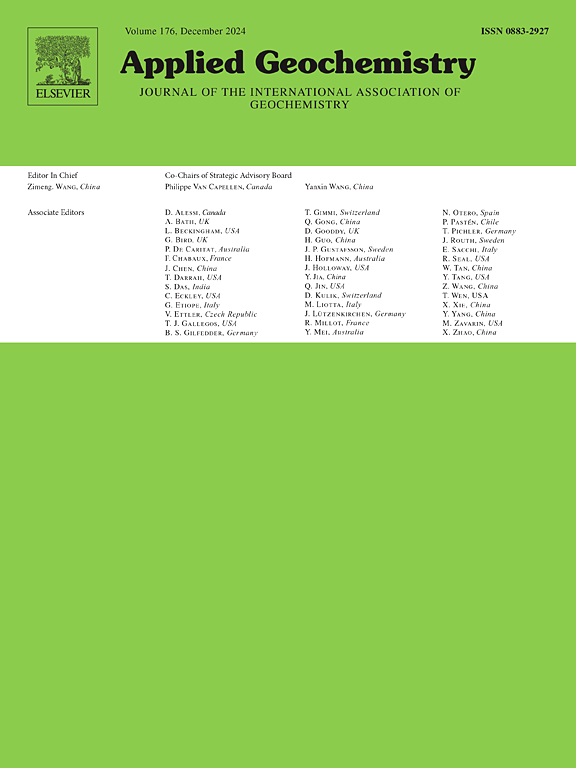Coupling of Fe and N cycles by nitrate-reducing Fe(II)-oxidizing microorganisms in the tidal sediments of an extreme acidic river (Río Tinto, Spain)
IF 3.4
3区 地球科学
Q1 GEOCHEMISTRY & GEOPHYSICS
引用次数: 0
Abstract
Río Tinto (Huelva, Spain) is an acid rock drainage-affected fluvial estuarine system where Fe(II)-oxidizing microorganisms were shown to be active both in the water column and in the top sediment layer, contributing to Fe mineral accumulation (up to 30 % of dry sediment weight) in the estuarian sediment. However, it is still unknown if the Fe(II)-oxidizing microorganisms thriving in the upper sediment layer are also capable of using nitrate present in the river (0.05–0.5 mM) as electron acceptor. We performed sediment incubations amended with either lactate, acetate-/NO3−-/Fe2+aq or NO3−/Fe2+aq to evaluate Fe-cycling processes and, specifically, if nitrate reduction coupled to Fe(II) oxidation (NRFeOx) can occur in the sediment under anoxic conditions. Geochemical data showed that in the NO3−-/Fe2+aq-amended setup, NO3− (from 1.5 to 0 mM), Fe2+aq (from 1.5 to 0 mM) and pH (from 6.0 to 5.4) decreased, while the poorly crystalline Fe(III) mineral pool increased by 6.9 % during 114 days of incubation. In the acetate-/NO3−-/Fe2+aq-amended setup, nitrate reduction rates (0.31 mM NO3−/day) were 10 times faster compared to the NO3−-/Fe2+aq-amended setup (0.03 mM NO3−/day). pH and poorly crystalline Fe(II) mineral content increased due to Fe(III) reduction after amendment with only lactate (0.26 ± 0.03 mM Fe2+aq/day) but also after amendment with acetate-/NO3−-/Fe2+aq (0.16 ± 0.02 mM Fe2+aq/day) suggesting that acetate-stimulated Fe(III) reduction superimposed Fe(II) oxidation coupled to nitrate reduction. Sequencing data showed that upon addition of nitrate, members of the genus Rhodanobacter increased by ⁓10 % in relative DNA-based 16S rRNA gene abundances in both acetate-/NO3−-/Fe2+aq- and NO3−-/Fe2+aq-amended setups. However, the Rhodanobacter RNA-based 16S rRNA relative gene abundance was higher in the acetate-/NO3−-/Fe2+aq-amended setup (11.15 ± 2.24 %) than in the NO3−-/Fe2+aq-amended one (5.40 ± 0.31 %). Combining geochemical and sequencing data obtained from anoxic sediment incubations, we conclude that NRFeOx processes, potentially catalyzed by the genus Rhodanobacter, can play a role in Fe cycling in this extreme acid rock drainage affected river, under low organic carbon (OC) conditions. At higher OC levels, NRFeOx microorganisms seem to become more active but their net effects on Fe(II) oxidation can be diminished due to the simultaneous activity of Fe(III)-reducers.

一条极酸性河流潮汐沉积物中硝酸盐还原Fe(II)氧化微生物对Fe和N循环耦合的影响(Río Tinto, Spain)
Río Tinto (Huelva, Spain)是一个受酸性岩石排水影响的河流河口系统,其中铁(II)氧化微生物在水柱和顶部沉积层中都显示出活性,有助于河口沉积物中的铁矿物积累(高达干沉积物重量的30%)。然而,尚不清楚在上层沉积物层生长的Fe(II)氧化微生物是否也能够利用河流中存在的硝酸盐(0.05-0.5 mM)作为电子受体。我们用乳酸、醋酸-/NO3−-/Fe2+aq或NO3−/Fe2+aq进行沉积物培养,以评估铁循环过程,特别是在缺氧条件下,沉积物中是否会发生硝酸盐还原耦合铁(II)氧化(NRFeOx)。地球化学数据表明,在NO3−-/Fe2+aq添加环境中,NO3−(从1.5 mM降至0 mM)、Fe2+aq(从1.5 mM降至0 mM)和pH(从6.0降至5.4)降低,而Fe(III)矿池的结晶度较差,在114 d的培养过程中增加了6.9%。在乙酸-/NO3−-/Fe2+aq修正的装置中,硝酸盐还原速率(0.31 mM NO3−/d)比NO3−-/Fe2+aq修正的装置(0.03 mM NO3−/d)快10倍。pH值和结晶度较差的Fe(II)矿物含量增加是由于仅用乳酸(0.26±0.03 mM Fe2+aq/day)和醋酸-/NO3−-/Fe2+aq(0.16±0.02 mM Fe2+aq/day)改性后的Fe(III)还原,表明醋酸盐刺激的Fe(III)还原叠加了Fe(II)氧化和硝酸盐还原。测序数据显示,在添加硝酸盐后,Rhodanobacter属成员在醋酸-/NO3−-/Fe2+aq-和NO3−-/Fe2+aq-修正设置中基于dna的相对16S rRNA基因丰度增加了⁓10%。乙酸-/NO3−-/Fe2+aq修饰的Rhodanobacter rna - 16S rRNA相对基因丰度(11.15±2.24%)高于NO3−-/Fe2+aq修饰的rRNA相对基因丰度(5.40±0.31%)。结合从缺氧沉积物培养中获得的地球化学和测序数据,我们得出结论,在低有机碳(OC)条件下,Rhodanobacter属催化的NRFeOx过程可能在这条极端酸性岩石排水影响的河流中发挥铁循环作用。在较高的OC水平下,NRFeOx微生物似乎变得更加活跃,但由于Fe(III)还原剂的同时活性,它们对Fe(II)氧化的净效应可能会减弱。
本文章由计算机程序翻译,如有差异,请以英文原文为准。
求助全文
约1分钟内获得全文
求助全文
来源期刊

Applied Geochemistry
地学-地球化学与地球物理
CiteScore
6.10
自引率
8.80%
发文量
272
审稿时长
65 days
期刊介绍:
Applied Geochemistry is an international journal devoted to publication of original research papers, rapid research communications and selected review papers in geochemistry and urban geochemistry which have some practical application to an aspect of human endeavour, such as the preservation of the environment, health, waste disposal and the search for resources. Papers on applications of inorganic, organic and isotope geochemistry and geochemical processes are therefore welcome provided they meet the main criterion. Spatial and temporal monitoring case studies are only of interest to our international readership if they present new ideas of broad application.
Topics covered include: (1) Environmental geochemistry (including natural and anthropogenic aspects, and protection and remediation strategies); (2) Hydrogeochemistry (surface and groundwater); (3) Medical (urban) geochemistry; (4) The search for energy resources (in particular unconventional oil and gas or emerging metal resources); (5) Energy exploitation (in particular geothermal energy and CCS); (6) Upgrading of energy and mineral resources where there is a direct geochemical application; and (7) Waste disposal, including nuclear waste disposal.
 求助内容:
求助内容: 应助结果提醒方式:
应助结果提醒方式:


